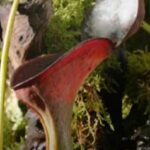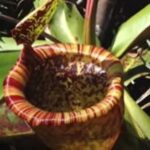As an Amazon Associate, this site earns commissions from qualifying purchases. For more details, click here.
Pitcher plants -whether it is nepenthes or sarracenia- are known for eating different types of insects. This is what makes the plant fascinating, but how safe is it as a houseplant? What happens if you touch it or your pet eats it? If this is what is holding you back from growing a nepenthes, this article is for you. Here we will separate the fact from fiction.
Pitcher plants are not toxic to humans or animals. The digestive fluids the plants secrete are not poisonous, and nothing will happen if the fluid makes contact with your skin.
Is a Pitcher Plant Dangerous to Humans?
Pitcher plants pose no threat to humans. The Malaysian snack food Lemang periuk kera consists of a pitcher plant filled with sticky rice prepared in coconut milk. It is a popular treat there, which goes to show how harmless nepenthes is. As long as the pitcher is cleaned first, you can put anything in there and use it for drinks or food.
But what about the digestive fluid pitcher plants produce? What happens if it gets on your skin? The answer is nothing. It is sticky sure but you can wash it off with water. There are no reports of people suffering skin irritation after making contact with these digestive fluids or enzymes.
Touching pitcher plants is safe too. Nepenthes cannot bite, sting or hurt your fingers even if you hold it. There is no way your hand will get trapped in its leaves either.
So if pitcher plants are safe for humans, where did the idea that they are harmful come from?
First, carnivorous plants have always raised that concern. Whether it is Venus flytraps, sundews or pitcher plants, it is the first question that people ask.
Since carnivorous plants eat meat, it is only natural to wonder if humans are part of their diet. But no they are not. For one, pitcher plants are too small. Second, their digestive system can only break down small insects and small worms. They can also eat fish food such as Hikari Betta BioGold Baby Pellets and it is good for them.
Movies have also portrayed plants as giant monsters capable of eating people. Unless pitcher plants grew several feet high, there is no danger to humans. And even if nepenthes does become large enough to eat people, their digestive system is only capable of digesting small insects.
Belief in man eating plants is very old and probably came from travelers’ tales. Even today there are still those wondering if nepenthes is toxic. They are not so you and your pet are safe. As it is the plant needs more protection from animals.
Related: Do pitcher plants eat humans?
Is a Pitcher Plant Poisonous to Cats and Dogs?
Pitcher plants pose no risk to cats or dogs. Your pet might get indigestion after eating but there are no serious long term effects. Pitcher plants are at greater risk of being eaten by pets.
Cats in particular are drawn to nepenthes and they are known to eat these. Eating a small amount will not cause harm. So if your cat eats plants, there is nothing to be worried about.
But too much of any plant including nepenthes might produce the opposite effect, indigestion. If cats consume large chunks of the plant, indigestion is likely.
Of course this assumes your cat or dog is healthy. If they are already sick and eat a pitcher plant it could worsen their condition. Some animals are also more sensitive to food than others so look out for any changes in behavior.
Take your pet to the vet if there is vomiting, mouth sores or they seem to lack energy. Inform the vet what happened so they can determine if the symptoms are due to eating the plant or something else.
But those situations are rare. It is usually the other way around and you have to protect the plant. Here are some suggestions on how to protect these plants.
Keep your cat busy with toys. You can buy catnip, or if you have paper boxes that should keep them occupied. Paper bags, cartons and scratching posts will hopefully deter them from your pitcher plant.
With cats it is more difficult, so try the toys suggested earlier. If your cat is strictly indoors your pitcher plant will be safe outside. But if both are the best option is to keep your pet busy.
Or you can grow your pitcher plant in a container like the Elegant Life Terrarium. Terrariums are suitable for most nepenthes but sarracenia are better suited for the outdoors.
Keep the pitcher plant away from your pet. With dogs it is easy, just put the plant somewhere high up so its paws cannot reach it.
How Do Pitcher Plants Catch Insects?
If pitcher plants are not poisonous then how do they kill and eat bugs? While there are many types of nepenthes – more than a hundred actually -, their feeding behavior is the same.
Pitcher plants use nectar and visuals to lure insects. When an insect lands on the pitcher rim, the slippery surface causes it to fall inside the cupped leaf. Liquids collectively known as phytotelmata dissolves the prey.
Pitcher plants got their name because of their shape, and it works well as a trap. The nectar keeps the rim slippery so when a bug lands to eat, it will lose its balance and fall in.
Even flying insects cannot escape the trap. Once they slip into the cavity, the liquids start dissolving the insect. Rainfall produces bacteria which helps the plant liquefy its food. In addition some nepenthes have insect larvae that feed on fallen prey. In turn their excrement is absorbed by nepenthes.
Like all carnivorous plants, nepenthes eat insects to obtain nutrients. Once consumed the prey is turned into urea, ammonium, phosphates, peptides and amino acids. These elements are converted into phosphorus and nitrogen.
Pitcher plants – like Venus flytraps and sundews – only grow in poor soil. Because plants need nitrogen, sarracenia and nepenthes have to get thee nutrients by other means. And the best source available are insects as they contain the nutrients the plant requires.
In other words, nepenthes do not poison their prey. They use digestive liquids to dissolve prey and extract nutrients. While the liquids are fatal to insects, it is not for humans or pets.
Pitcher Plant Care for Beginners
There are many types of pitcher plants but their requirements are essentially the same. Here are some basic guidelines to keep in mind. As long as you care for these plants they should be fine. And you will see, they do not need a lot of maintenance.
Feeding, Nutrition and Food
How you feed pitcher plants depends on their location. If the plant is outdoors or by an open windowsill, you probably do not need to feed them. The nectar will draw insects and other prey to it. Do not feed your nepenthes if it gets food on its own.
If there are very few insects in your home, give it fish flakes. Unless you like hunting for flies, mosquitoes and other bugs, fish food will be fine. Pitcher plants cannot eat foods for human consumption so avoid those. Freeze dried bloodworms and mealworms are also good for pitcher plants as well as betta fish pellets. Feed the plant 1-4 times a month. You can feed just one pitcher or two.
Light and Temperature
Pitcher plants require at least six hours of sunlight every day. The ideal temperature is 60-85 F (15.5-29 C). A warm location with high humidity stimulates growth.
Just like with most plants, nepenthes benefits from several hours of light. Six hours is the minimum but obviously the more light the better. You can also use grow lights during overcast days.
Pitcher plants will be fine indoors as long as it gets enough light, food and water. If the temperature climbs over 90 degrees, look for signs of sunburn or dried out leaves. Move the plant under partial shade until the temperature drops below 85 degrees.
Related: Do pitcher plants need sunlight
Soil and Water
All carnivorous plants naturally grow in poor soil. Planting them in rich potting media (the type used with houseplants) will kill them. You must only use nutrition free media for pitcher plants.
The best soil for pitcher plants is a 1:1 mix of peat moss and perlite. Keep the soil moist at all times during its growth season (from early spring to fall in October). Some pitcher plants require dormancy. This can last 5 months so find a suitable location for it.
Conclusion
Pitcher plants are safe to grow in a garden and in your home. It is a beautiful plant and can be a true centerpiece in your collection. So no need to worry about any harm coming to you or your pets.

My fascination with carnivorous plants began many, many years ago with Venus Fly Traps. Now I am more than happy to impart what I know with other enthusiasts and those who are curious about meat eating plants.



